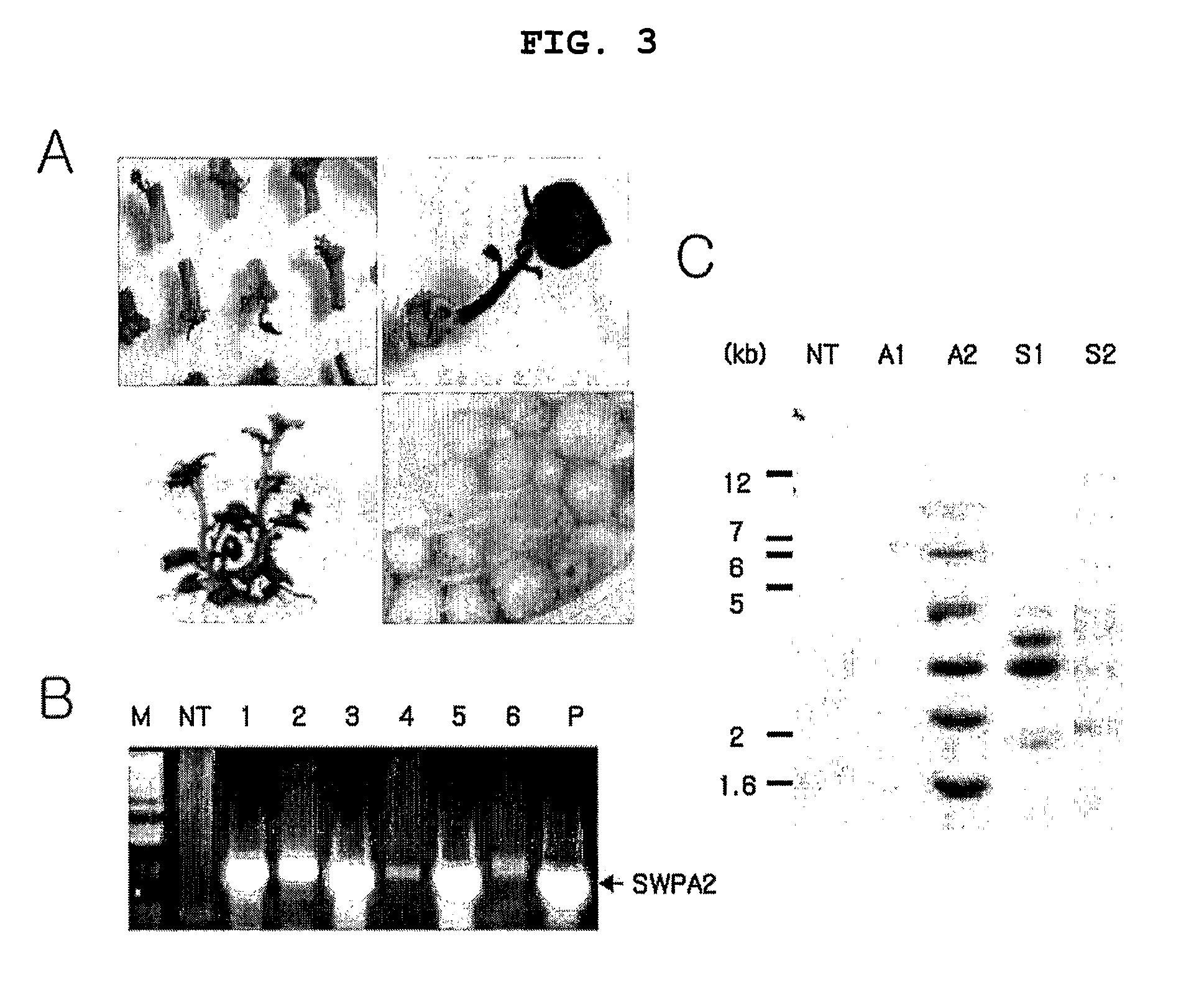Expression vectors pSSA-K and pSSA-H for expression of SOD and APX in plants to provide stress tolerance
a technology of stress tolerance and expression vectors, applied in the field of recombinant expression vectors for plant production, can solve the problems of physiological disorders and serious physiological disorders, and achieve the effects of reducing the risk of injury
- Summary
- Abstract
- Description
- Claims
- Application Information
AI Technical Summary
Benefits of technology
Problems solved by technology
Method used
Image
Examples
example 1
Construction of pSSA-K and pSSA-H, Expression Vectors for Multiple Stress Tolerant Genes
[0065]The present inventors constructed a vector by ligating cDNA (GenBank accession number AF170297, Lee, et al., Mol. Gen. Genet., 262: 807-814, 1999) coding CuZnSOD (CuZn superoxide dismutase, mSOD1) of cassava represented by SEQ. ID. No 16 and cDNA coding APX (ascorbate peroxidase; Randy, et al., Free Rad. Biol. Med., 23: 473-479, 1997) of pea represented by SEQ. ID. No 17 to oxidative stress inducible SWPA2 promoter (Korean Patent Publication No: 2001-51095; International Publication No: WO 01 / 31018) represented by SEQ. ID. No 15.
[0066]Particularly, PCR was performed using primers each represented by SEQ. ID. No 1 and No 2 at 94° C. for 1 minute, at 51° C. for 1 minute, at 72° C. for 1 and half minute (this cycle was repeated 30 times) to amplify SWPA2 promoter sequence. And the amplified SWPA2 promoter sequence was cloned into pGEM-T Easy plasmid vector (Promega, USA) according to the manuf...
example 2
Preparation of a Transgenic Potato Transformed with pSSA-K Expression Vector
Preparation of a Transgenic Potato Plant
[0071]The present inventors prepared a transgenic potato plant by co-culturing leaf discs of a potato plant and Agrobacterium tumefaciens EHA105 containing pSSA-K vector constructed in the above example 1.
[0072]Particularly, the potato plant (Solanum tuberosum L.) used for the transformation herein was prepared by culturing Superior, the most world-widely cultivated variety, and Atlantic, a variety for processing, in an incubator. The potato plant was cultured in MS medium (Murashige and Skoog, Physiol. Plant., 15: 473-497, 1962) supplemented with 3% sucrose with the light condition of 16-hour light / 8 hour dark under cool-white fluorescence (40 μmol·m−2·sec−1) in a 25° C. incubating room. After culturing 2 weeks, petiole and the second or the third leaf on the upper part of shoot, were separated and used as materials for plant transformation.
[0073]5 ml of LB medium (b...
example 3
Preparation of a Transgenic Sweetpotato Plant by Using pSSA-K Expression Vector
Preparation of a Transgenic Sweetpotato Plant
[0077]The present inventors transformed sweetpotato embryogenic callus by particle bombardment using pSSA-K vector constructed in the above example 1.
[0078]Particularly, embryogenic callus of sweetpotato (Ipomoea batatas Lam.; Variety: Yulmi) being cultivated in Korea was used as transformation material in this invention. More precisely, embryogenic callus of sweetpotato was induced and maintained to establish sweetpotato plant regeneration system (Kwon, et al., Korean J. Plant Biotechnol., 29: 189-192, 2002).
[0079]The embryogenic callus was cut by cell clusters into 1-2 mm in diameter. The cell clusters were placed within a central circle in 2 cm in diameter on MS solid medium supplemented with 1 mg / l of 2,4-dichlorophenoxy acetic acid (2,4-D), which was cultured for one day, followed by particle bombardment (FIG. 4A). More precisely, plasmid DNA of pSSA-K ve...
PUM
| Property | Measurement | Unit |
|---|---|---|
| temperature | aaaaa | aaaaa |
| temperature | aaaaa | aaaaa |
| temperature | aaaaa | aaaaa |
Abstract
Description
Claims
Application Information
 Login to view more
Login to view more - R&D Engineer
- R&D Manager
- IP Professional
- Industry Leading Data Capabilities
- Powerful AI technology
- Patent DNA Extraction
Browse by: Latest US Patents, China's latest patents, Technical Efficacy Thesaurus, Application Domain, Technology Topic.
© 2024 PatSnap. All rights reserved.Legal|Privacy policy|Modern Slavery Act Transparency Statement|Sitemap



